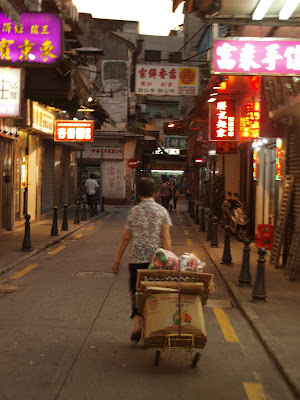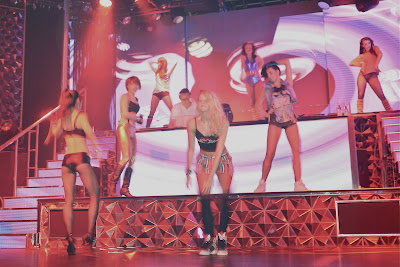After our delicious breakfast, we went down the escalator one floor to see the fresh produce and clothes and then to the ground floor to check out the meat and fresh fish. Similar in some ways to a Mexican market, the bits of animal they choose to display are so different. Stacks of pig snouts, fish cut open like an anatomy illustration to reveal the bloated entrails. Freshness seems paramount in Hong Kong. Most of the fish on offer is alive until the moment you buy it. Each stall has a small selection on ice but a vast collection of see-through containers or shallow stainless tanks with an elaborate hose system to water & aerate the fish, keeping them happy(ish) until they get clobbered over the head. Eels, lobster, razor clams, toads, more varieties of fish than I’ve seen in any aquarium. We wandered around outside the market going in and out of local shops before heading back to the house to pick up Abby & Alistair before heading off to Macau for the night.
Down to the ferry station for our one-hour jetboat over to Macau. James had a shared djing gig at a Macau Club for the night and we were thrilled to tag along. Mild-mannered investment guy by day… We settled into our hotel room and then headed out to check out a bit of old Macau. Handed back to China in 1998, the colonial past far more present here than in Hong Kong. The garish flash of the casinos and the new money they bring clashing with the muted pastels, delicate mosaic tilework and narrow alleys snaking off in every direction. The historical element here is a far cry from the unsentimental modernity of Hong Kong. After losing track of our destination, a request for directions landed us a private guide most of the way. The presence of Portuguese on all the street signs and commerces a vestige of old times but if anyone speaks Portuguese here I didn’t hear a word of it. The handover of Macau meant China being able to fully develop the casino angle of a local economy that was tanking. And develop it they have. It seems the Macanese welcomed the end of Portuguese dominion slightly more than the Hong Kongers the British. The visitors here are predominantly Asian, as is the staff, but none speak the same language so Malay, Philipino, Chinese and Japanese struggle in an inelegant but charming English devoid of pronouns and conjunctions.
We walked up to the Fortaleza de Monte to see the mounted canons and walls and watched a woman practicing her martial art/fan-dancing in front of the closed museum’s mirrored windows. The skyline is colourful, the landscape uneven. If it weren’t for the sampans in the harbour I’d say almost mediterranean but its charm almost negated by the spectacularly ugly Hotel Lisboa. As Wil says, the building permit must have been issued before the inspector saw the plans. We wandered around trying to get lost, Alice bowing her head three times and making a wish at every little shrine along the way. One or more characters in Cantonese painted on a red backdrop, a little red pot of sand at its feet with a few sticks of burnt incense sit near the doorway of almost every building. Scooters zipped by and old ladies hustled past pulling carts of folded cardboard into alleys too narrow for all but the smallest cars.We were a little late getting going but after a nice dinner and a couple of bottles of Albarinho at a Portuguese restaurant, we tucked in the kids and jumped in a cab to head to the club. We went across the bridge to the southern section of Macau, on a piece of reclaimed land called Cotai between Taipa and Coloane. The Cotai strip is like Las Vegas but because the roads are so wide and the buildings so far apart it has less of the Disney feel of Vegas where the behemoths lose something in stature standing shoulder to shoulder with other giants. The casinos here stand alone and really feel mammoth. I later discovered that in terms of floor space, the Venetian, Macau’s largest casino, is the world’s sixth largest building. That might explain it! We pulled up in front of City of Dreams, the rain of an incoming typhoon starting to pepper the windscreen. We raced through the building, James up front with his record bags, finally finding Cubic (“Macau’s Largest and Most Prestigious Club”). The doormen were frosty until James announced he was the DJ. The velvet rope hit the floor with apologies and we were escorted inside. The place was huge. A semi-circular space with a three-tier stage on the span end. There was some question as to where the DJ booth was until we finally noticed James’s fellow DJ, Roy, on the middle section of the stage behind the turntables. Bars lined the walls with creative displays of champagne bottles, small standing tables stood near the back and a dozen or more round black leather-upholstered booths formed a semi-circle facing the stage. One elevated booth sat front and centre, all red velvet, lit from above, its opening leading directly on to the dance floor at the foot of the stage. On the table of each round booth was a huge, oval, illuminated ice bucket decorated with Perrier-Jouet flowers. Champagne flutes for ten sat nearby. Between each booth stood a waitress, primed for the crowds we worried might fail to appear with a forecasted typhoon wreaking havoc on jetfoil schedules from Hong Kong and mainland China. On the second floor of the club were a series of private rooms leading on to their own balconies overlooking the action. We visited one and it was like walking onto a movie set. Low ceilings, bright red upholstered banquettes, overstocked bar, everything else molded glossy plastic or glass or gold and garish detailing. Ornate doesn’t even begin to cover it. I tried desperately to take stock of it all but it was just too much to take in. Suffice it to say, if you’re ever looking for the perfect set for a mafia party, Cubic is your place. The evening’s theme was 80s and 90s so my foot was tapping to every song but it was a bit strange realizing that Wil, Abby, James, Roy and I weren’t just the only ones who knew any of the tunes but were probably the only ones alive when they first hit the charts. We were almost alone in the place for a long time, sipping the bottle of champagne that was opened when we sat down. The only other table was occupied by a group that could have passed as extras from Blade Runner. Let’s just say cartwheels would not have come as a surprise. The club staff fawned over Abby, a music biz celebrity in this half of the world.
The music blasted, the lightshow flashed, the champagne flowed. An hour or so later a foursome of girls dressed in fishnet and hotpants materialized on the surfaces between the booths and started gyrating. After four songs, they crouched down and scurried off back stage. James and Roy stood facing the growing crowd, screens of lights flashing above and below them. On either side of the stage was an illuminated staircase. The next time the dancing girls came out there were ten of them, the four Asian girls from before and six western girls dressed Like a Virgin. The place filled up. The marketing manager who shared our table assured us that every table in the place was fully booked between two and four a.m. Groups of people were led in by the hostess who installed them in a booth. The delivery system for drinks was a ceremony — a procession of male staff arrived holding a champagne bottle and a giant sparkler overhead in each hand. Once at the table, the champagne and sparkler were transferred to the waitresses who stood facing the patrons. The sparklers were half an inch across, a foot long and burned at least three minutes long. When the last one burned out, the girls installed them in the ice bath and started pouring. Every single champagne bottle, magnum or otherwise left the bar with a lit sparkler. The appeal of ordering champagne suddenly lost its charm for me but obviously had the opposite effect on the clientèle as the drunk patrons tried to outdo each other. Soon enough, the place was ablaze with sparklers, with tables of two ordering ten bottles of champagne (at 2500 HK$ a pop!).
The clientèle in the booths was almost exclusively Asian which Abby guessed were mostly second-generation cash and Triad. The booth between us and the stage held five near-teenage couples who postured and pumped their arms in the air… until the bill came and they scurried around the table trying to come up with the cash. Ten kids, ten iphones. There were more photos posed for, taken and posted in the space of an hour than I’ve ever seen. At times all ten heads were hunched over, fingers tap-tapping at their little screens until a fresh outburst of hand-pumping and photo taking. The table right beside theirs held a group of ten older mainland Chinese, nine men and one woman who also had ten bottles delivered to their table. The attending waitress half-filled their flutes, the ten knocked their glasses together and downed the champagne in a gulp. Champagne shooters?! Sacrilege!!! They worked their way through all ten bottles that way. It was painful to watch. Sadly, that is how all the champagne (except ours) in the club was consumed. Some tables moved on to Cognac after their run of champagne was done. I kept thinking of wine-makers the world over turning in their graves. When the drinks list or the bill was presented, a staff member magically appeared wielding a little flashlight to help the patron see just how much it was going to hurt. Abby and Wil estimated that on a good night, the club probably pulled in over a million dollars. The highlight of the evening was, without a doubt, watching James at work, surrounded on all sides by dancing girls shaking their booties in his general direction.
Just as we were leaving (at 2:30) a group was finally shown to the red velvet booth. The marketing woman told us it cost 50,000HK$ (7,000$ Canadian) a night to book (just to occupy the space mind, NOT with drinks!)




















